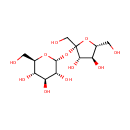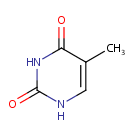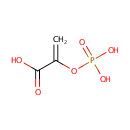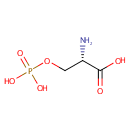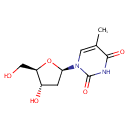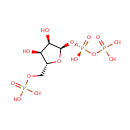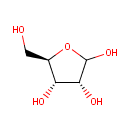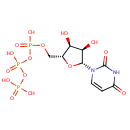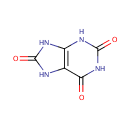
Search Results for compounds
Searching compounds for
returned 4373 results.
Sucrose (PAMDB000109)
IUPAC:
(2R,3R,4S,5S,6R)-2-{[(2S,3S,4S,5R)-3,4-dihydroxy-2,5-bis(hydroxymethyl)oxolan-2-yl]oxy}-6-(hydroxymethyl)oxane-3,4,5-triol
CAS: 57-50-1
Description: Sucrose is a nonreducing disaccharide composed of glucose and fructose linked via their anomeric carbons. Sucrose can be used as a carbon/energy substrate by Pseudomonas aeruginosa. The sucrose porin (ScrY) which resides in the bacterial outer membrane facilitate the passive diffusion of sucrose into the cell. Sucrose metabolism is controlled by the csc regulon. The csc regulon comprises three genes for a sucrose permease, a fructokinase, and a sucrose hydrolase (genes cscB, cscK, and cscA, respectively).
Thymine (PAMDB000110)
IUPAC:
5-methyl-1,2,3,4-tetrahydropyrimidine-2,4-dione
CAS: 65-71-4
Description: Thymine is a nucleobase that is also known as 5-methyluracil. As the name suggests, thymine may be derived by methylation of uracil at the 5th carbon. In RNA, thymine is replaced with uracil. In DNA, thymine (T) binds to adenine (A) via two hydrogen bonds, thus stabilizing the nucleic acid structures. Thymine combined with deoxyribose creates the nucleoside deoxythymidine, when it is combined with ribose it creates the nucleoside thymidine. Thymidine can be phosphorylated with one, two, or three phosphoric acid groups, creating, respectively, TMP, TDP, or TTP
Phosphoenolpyruvic acid (PAMDB000111)
IUPAC:
2-(phosphonooxy)prop-2-enoic acid
CAS: 138-08-9
Description: Phosphoenolpyruvate (PEP) plays a key role in many metabolic reactions. It has a high energy phosphate bond, and is involved in glycolysis and gluconeogenesis. In glycolysis, PEP is formed by the action of the enzyme enolase on 2-phosphoglycerate. Metabolism of PEP to pyruvate by pyruvate kinase (PK) generates 1 molecule of adenosine triphosphate (ATP) via substrate-level phosphorylation. ATP is one of the major currencies of chemical energy within cells. In gluconeogenesis, PEP is formed from the decarboxylation of oxaloacetate and hydrolysis of 1 guanosine triphosphate molecule. This reaction is catalyzed by the enzyme phosphoenolpyruvate carboxykinase (PEPCK). This reaction is a rate-limiting step in gluconeogenesis. (wikipedia)
Phosphoserine (PAMDB000113)
IUPAC:
(2S)-2-amino-3-(phosphonooxy)propanoic acid
CAS: 407-41-0
Description: Phosphoserine is phosphoric acid ester of serine. As a constituent (residue) of proteins, its side chain can undergo O-linked glycosylation. It is one of three amino acid residues that are commonly phosphorylated by kinases during cell signalling. Phosphorylated serine residues are often referred to as phosphoserine.
Thymidine (PAMDB000114)
IUPAC:
1-[(2R,4S,5R)-4-hydroxy-5-(hydroxymethyl)oxolan-2-yl]-5-methyl-1,2,3,4-tetrahydropyrimidine-2,4-dione
CAS: 50-89-5
Description: Thymidine is non-toxic and is a naturally occurring compound that exists in all living organisms and DNA viruses. 25% of DNA is composed of thymidine. RNA does not have thymidine and has uridine instead. Thymidine is a chemical compound which is a pyrimidine nucleoside. Thymidine is the DNA base T, which pairs with adenosine in double stranded DNA.
Phosphoribosyl pyrophosphate (PAMDB000115)
IUPAC:
[({[(2R,3R,4S,5R)-3,4-dihydroxy-5-[(phosphonooxy)methyl]oxolan-2-yl]oxy}(hydroxy)phosphoryl)oxy]phosphonic acid
CAS: 7540-64-9
Description: Phosphoribosyl pyrophosphate (PRPP) is a pentosephosphate. The key substance in the biosynthesis of histidine, tryptophan, and purine and pyrimidine nucleotides. It is formed from ribose 5-phosphate by the enzyme ribose-phosphate diphosphokinase. It plays a role in transferring phosphate groups in several reactions. (Wikipedia)
Ribose (PAMDB000116)
IUPAC:
(3R,4S,5R)-5-(hydroxymethyl)oxolane-2,3,4-triol
CAS: 50-69-1
Description: Ribose is a pentose that is actively used in many biological systems usually in its D-form. Ribose constitutes the backbone of RNA, a biopolymer that is the basis of genetic transcription. It is related to deoxyribose, as found in DNA. Once phosphorylated, ribose can become a subunit of ATP, NADH, and several other compounds that are critical to metabolism like the secondary messengers cAMP and cGMP. In cells D-ribose must be phosphorylated before it can be used. Ribokinase catalyzes this reaction by converting D-ribose to D-ribose 5-phosphate.
Uridine triphosphate (PAMDB000117)
IUPAC:
({[({[(2R,3S,4R,5R)-5-(2,4-dioxo-1,2,3,4-tetrahydropyrimidin-1-yl)-3,4-dihydroxyoxolan-2-yl]methoxy}(hydroxy)phosphoryl)oxy](hydroxy)phosphoryl}oxy)phosphonic acid
CAS: 63-39-8
Description: Uridine 5'-(tetrahydrogen triphosphate). A uracil nucleotide containing three phosphate groups esterified to the sugar moiety. Uridine triphosphate has the role of a source of energy or an activator of substrates in metabolic reactions, like that of adenosine triphosphate, but more specific. When Uridine triphosphate activates a substrate, UDP-substrate is usually formed and inorganic phosphate is released. (Wikipedia)
Uridine 5'-monophosphate (PAMDB000118)
IUPAC:
{[(2R,3S,4R,5R)-5-(2,4-dioxo-1,2,3,4-tetrahydropyrimidin-1-yl)-3,4-dihydroxyoxolan-2-yl]methoxy}phosphonic acid
CAS: 58-97-9
Description: 5'-Uridylic acid is a uracil nucleotide containing one phosphate group esterified to the sugar moiety in the 5' position.
Uric acid (PAMDB000119)
IUPAC:
2,3,6,7,8,9-hexahydro-1H-purine-2,6,8-trione
CAS: 69-93-2
Description: Uric acid is a heterocyclic purine derivative that is the final oxidation product of purine metabolism. It is produced by the enzyme xanthine oxidase, which oxidizes oxypurines such as xanthine into uric acid.
